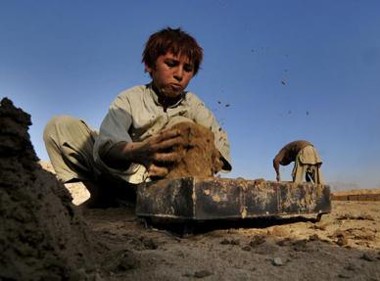Reuters, March 19, 2010
Afghan children face world’s worst conditions - U.N.
More than a quarter of Afghan children -- 257 out of 1,000 -- will die before they reach their fifth birthday and 165 out of every 1,000 will die in the first year of their lives, more than any place in the world
By Jonathon Burch
HERAT, Afghanistan - Afghanistan is the hardest place in the world to be a child, the South Asia regional director for UNICEF said, with high child mortality rates, poor levels of nutrition and rampant sexual abuse.

Young Afghan day labourers Amin, 13 (L) and his brother Taza, 12, make bricks on the outskirts of Kabul. Already, 30 percent of Afghan children aged 5 to 14 are engaged in some form of work. (Photo: AFP)
"The situation in Afghanistan as a whole is one of the most dramatic in South Asia and also in the world. Afghanistan is the most difficult place to be born as a child," Daniel Toole said on a visit to Afghanistan this week.
"If I could take one challenge, it's survival."
Three decades of war and a worsening insurgency have made it ever tougher for an Afghan child just to survive, Toole told Reuters during a visit aimed at highlighting what UNICEF calls the worst conditions for children on earth.
One of the girls he had just met in a woman's shelter was only nine years old when she was forced to marry a total stranger. Another was just 11.
More than a quarter of Afghan children -- 257 out of 1,000 -- will die before they reach their fifth birthday and 165 out of every 1,000 will die in the first year of their lives, more than any place in the world, according to UNICEF data from 2008.
Afghanistan also has the second highest maternal mortality rate in the world after Sierra Leone, with 1,800 women per 100,000 live births dying during child birth, according to UNICEF estimates from 2005.
"On top of that, we overlay the conflict, and so children are being displaced, their food production has been disrupted, so the chances of being yet further endangered by the security situation ... make it that much more dramatic," said Toole.
"DRAMATIC STORIES, PAINFUL STORIES"
Violence in Afghanistan is at its worst levels since a U.S.-led invasion in late 2001 overthrew the Taliban. Since then, intense fighting between insurgents and foreign and Afghan troops has forced thousands of civilians to flee their homes.
An increasing number of children are also fleeing across Afghanistan's borders, said Toole, with many turning up as far away as Western Europe without their parents.
Last April, 24 Afghan children aged between 14 and 16 were found living on a sidewalk of a railway station in Rome. The Save the Children aid group said Afghan children now made up one of the biggest groups of unaccompanied minors in the city.
Other major problems facing children in Afghanistan, particularly girls, said Toole, is underage marriage and sexual abuse. Forty-three percent of girls aged 20-24 were married before they were 18, according to UNICEF figures from 2009.
Girls are often married against their will to men more than twice their age and are forced to have sex with their husbands before they reach puberty.
Toole described a visit he made to a women's shelter supported by UNICEF in the western city of Herat. The shelter is the only place in the city where girls who have been sexually abused or married at a young age can seek refuge.
"Two young girls, one who was nine who was married. She didn't even know she was being married until she arrived and was told, 'here is your husband'. Another married at 11 against her will," said Toole after meeting the girls at the shelter.
"Dramatic stories, painful stories, but I think it's the tip of the iceberg. I found myself thinking, 'how many girls have had this happen and and can't get to this centre?'," he said.
But despite the difficulties facing Afghan children, Toole said progress was being made, especially in education with an increasing number of girls being sent to school. "There is a lot of improvement but there is still so much more to do here, even if I just think about survival," Toole said.
(Editing by Sugita Katyal)
Characters Count: 4661
